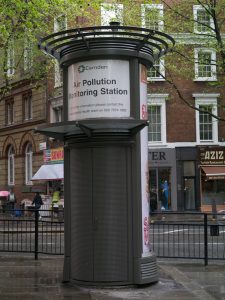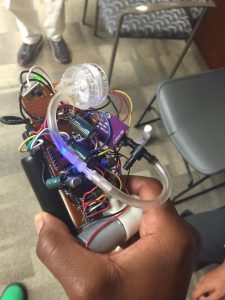Wearables have the potential to impact lives and even shape policy in the area of environmental health. From step counters to sleep monitors, wearables are increasingly changing the way in which people think about their health.
Designers are now exploring what potential wearables hold toward helping us improve the health of our environments, especially as they relate to our health. According to a report issued by the International Energy Agency in 2016, each year about 6.5 million deaths worldwide are linked to air pollution, which is likely to increase unless we make a sustained effort to reduce global emissions.
The ability to collect data that offers an idea on how everyday exposure to pollution effects individuals as they move from location to location restricts politicians’ ability to write effective environmental policy. The current pollution monitoring network in most cities make use of stationary air-monitors that only monitor a small number of pollutants. While such data is useful, it does not provide an image of what everyday exposure to pollution looks like. Leveraging wearable technology promises to collect data on pollution exposure at an individual level could aide policymakers in designing more effective environmental policy.
This idea of collecting data through wearables originates from participatory urbanism, which is the leveraging of ubiquitous technologies to enable citizen action through measuring, sharing, and remixing elements of urban living. For example, mobile phones have been successfully used as environmental sensing and data collection devices. As part of participatory urbanism, human beings become sensors as smaller parts of a larger sensing network. For example, these sensors could help monitor nitrogen dioxide, particulate matter, and sulfur dioxide, which are the most common pollutants release from vehicle exhaust and negatively impact both environmental and human health.
Most air pollution studies make use of stationary air monitoring stations (a London station pictured at right), and do not take into account the different levels of pollution exposure people encounter on a daily basis. However, technologies like wearables afford us the opportunity to map environmental data in real time and provide a better picture of pollution exposure that can aid our abilities to advocate for political change.
Some commercially available wearable sensors already exist. Lapka PEM can measure radiation, electromagnetic fields, humidity, and nitrate levels in produce. AirBeam is an air monitor that maps pollution exposures in real-time through an open-source platform called “Aircasting.” The device is a lanyard, which uses light scattering to measure airborne particulate matter, and crowdsources individual users’ data to show areas of concern. The best feature of this product is that it offers suggestions to users, which would help users reduce or avoid risk entirely.
Several of the developers of these products raise the idea of a future where wearables can give us the information we need to help us make better environments. While environmental health-oriented wearable technology may aid us in making smart policy decisions, there are considerations of agency, access and equity that we will need to take into account.
First, since features (or what data is collected) are predetermined, users have no agency in deciding what data should be tracked, especially as it relates to their individual health concerns, such as how other factors (e.g., sulfur dioxide) beyond airborne particulate matter can trigger asthma attacks. Developers also often fail to help users understand the reasons devices collect certain types of data. From a communication design standpoint, it is advantageous to help users understand how individual data points coalesce in their total environment to impact their health.
Education plays a significant role in not only heightening environmental awareness, but also shaping attitudes and behaviors. While it is not the only barrier, a lack of access to knowledge makes it incredibly difficult for residents to participate in conversations about environmental science and decision-making that will impact their lives. For example, consider how knowing the effects of low-level exposure to a toxic chemical provides offers you more agency to communicate with experts or argue effectively against plans to site a factory near your community. Therefore, developers have to see these technologies as avenues of access toward participating in science. Developers must create technologies that help users understand the science of their environments, so that they can feel comfortable having conversations about science and the role it plays in our lives. Such a goal parallels tightly with the National Academy of Science’s move to encourage more learning of science in informal environments.
Second, developers also need to pay careful attention to issues of data ownership and consent. Most commercially available wearables are made by private entities touting their products for the public good. Users often assent to providing data to companies when operating their products; however, there are times where participants do not realize that they are providing data to a company that might monetize their data by selling it to a third-party or charging users a fee to access their own data in the future.
Furthermore, there is always the potential of theft of data stored on either a device or in an unsecured cloud-based service. As TechRepublic’s Teena Maddox aptly warns, it’s not unlikely that a third-party could steal and make user data available to health insurance companies, which could result in higher premiums for individuals living on or near polluted sites. And while you might not care that a third-party hacker has access to data that shows you only get 5 hours of sleep, you should know that companies are taking this threat seriously by purchasing data breach insurance. Even if these technologies are being developed for the public good, developers need to remain critical regarding their potential to harm.
Finally, devices often present huge cost barriers to users. This is where access to technology cuts across class and racial divides and serves as the biggest obstacle to participatory urbanism. Obstacles to participation in decision making processes as well as specific policies, events, and outcomes in which minority communities are targeted for the placement of polluting industries is environmental racism.
From available data, researchers know that the communities impacted the most by pollution are predominately poor communities of color. These tend to be the areas where environmental health data collection is needed the most, because of high incidences of pollution-related health concerns; however, there are often not enough resources or personnel to monitor polluting industries within these environmental justice communities. As a corrective to environmental racism, the environmental justice movement seeks to ensure fair treatment and meaningful involvement of all people regardless of race or income in the development, implementation, and enforcement of environmental policy.
The price of environmental data-collecting wearables can range from hundreds to thousands of dollars depending upon features and availability, which immediately prices poor individuals out of participation. Moreover, the adoption rate of wearables in general is estimated to rise to 21.1 percent by 2020 with a reach 15.8 percent of the US population. Such a stark estimate raises the conditions of social stratification and de facto technological racial and class segregation. This means that leveraging wearables in order to have a positive impact on environments can only work, when developers target all communities, rather than only consumers who can afford to buy expensive technology, as the focus of their development efforts. If developers cannot design technologies at more affordable levels and market them to users within impacted poor communities, we further the logics of environmental racism by ensuring mostly white, affluent constituencies can benefit more than others.
While all of these shortcomings appear as obstacles to development, they are also ideas for innovation that can aid understanding of how individuals’ exposure to pollution changes as they move throughout their everyday environments. With this data, policymakers can better understand science in a way that can help protect vulnerable people living in the most polluted communities.
Donnie Johnson Sackey is an assistant professor of English at Wayne State University, a senior researcher with Detroit Vision for Environmental Research through Science & Engagement (D•VERSE) and affiliated researcher with MSU’s Writing, Information & Digital Experience (WIDE) Center.




A legacy of conservation; a commitment to sustainability.
3700 E. Gull Lake Drive
Hickory Corners, MI 49060
(269) 671-5117
info@kbs.msu.edu